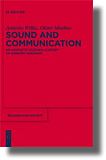Wilke, Annette [u.a.]:
Sound and Communication : an Aesthetic Cultural History of Sanskrit Hinduism / Annette Wilke ; Oliver Moebus. - Berlin : de Gruyter, 2011. - xxiv, 1112 S. + 1 Audio-CD. - (Religion and Society ; 41)
ISBN 978-3-11-018159-3
EUR 159,95 / US$ 224,00
DDC: 294.5514
-- Angekündigt für Januar 2011 --

Beschreibung
Im hinduistischen Indien ist neben Oralität auch Sonalität seit frühester Zeit von hoher kultureller Wertigkeit. Sie prägt den Umgang mit Texten, inspiriert eigene Riten, Modelle kosmischer Ordnung, abstrakte Formelsprachen und dient der Stimulierung und Versinnlichung religiöser Gefühle. Auf der Basis von Klangwahrnehmung und -deutung entwickeln die Autoren eine unorthodoxe Kulturgeschichte Indiens und thematisieren einen wichtigen, meist vernachlässigten Aspekt gelebter Religiosität. Ein stimulierender Beitrag zu kulturellen Wahrnehmungssystemen, der auch in die Debatte zu Oralität und Literalität neue Aspekte einbringt. [Verlagsinformation]
Inhalt
Foreword. v
I. METHODOLOGY. 1
1. Hinduism as a Culture of Sound. 1
1.1 Notes on Theory, Method and Scope of Inquiry. 11
1.2 Applied Aesthetics of Religion. 25
1.3 Sanskrit Hinduism and Phonocentrism of Sanskrit Culture. 38
1.4 Texts in Practice and the Performativity of Texts. 52
1.5 Communication and Reception of Sounding Texts. 71
1.6 Orientation on Scriptures and Orientation on Sounds - Religions Compared. 130
1.7 The Power of the Media and their Cultural Contingency. 175
1.8 Literati in India and Europe. 225
1.9 From Media Technology to the Symbolic Forms as Cultural Media. 267
1.10 Sound Rituals of the Goddess Language - Symbolic Forms of Language and Sound. 278
1.11 Considerations of Cultural Theory on Emancipation and Participation as Guiding Heuristic Difference. 320
II. HISTORY. 331
2. The Veda as a Basic Paradigm for Sacred Language and Sacred Sound. 331
2.1 Performance and Aura. 11
2.2 The Veda as Cultural Memory: Eternal Knowledge and the Ever Fresh Vedas. 347
2.3 Evocation and Expression: the Early Ṛgveda. 359
2.4 Professionalisation of the Sacrificial Language: Late Saṃhitā and Brāhmaṇas. 378
2.5 Semanticization and Language Act: the Yajur-Veda. 404
2.6 Sound Rituals: The Sāma-Veda. 423
2.7 OṂ in the earlier Upaniṣads. 443
2.8 OṂ in the later Upaniṣads. 450
3. Composition and Decomposition: Analytical Studies and Popularizations of the Veda - Rationality and Aesthetics of Post-Vedic Literatures and Performing Arts. 457
3.1 The Nostalgia of the Bards. 457
3.2 Theistic "Topping" of the Veda in Litanies and Purāṇas. 462
3.3 Auxiliary Vedic Studies: Systematics and Abstractions. 472
3.4 Theater as the Fifth Veda and the Theory of Aesthetic Moods. 504
3.5 Entertaining Learning in Theater and Remythification of the Science of Grammar in Light Reading. 519
4. Pluralism and the Search for Orientation: De-Sacralization and Re-Sacralization of Language in Poetics, Linguistics, and Metaphysics. 525
4.1 Courtly Poetry: Ornate and Expressive Speech. 530
4.2 Brahmanical Aggiornamento: Rationalist Challenges and the Rise of Veda Hermeneutics. 548
4.3 The Pūrva-Mīmāṃsā and their Theory of the Eternal Validity of Words and Sounds. 551
4.4 The Uttara-Mīmāṃsā and their Communication of the Non-Verbal. 584
4.5 Bhartṛhari's "Linguistic Turn" and His Metaphysics of Language. 615
5. Performance and Sensuality: the Sound Universes of Tantra and Devotionalism. 664
5.1 The Tantric "Weaving Frame": Notes on Definition, Actors and Politics. 674
5.2 Sex and Crime with the Tantrists: Othering Discourses in East and West. 684
5.3 Mantras as Divine Self-Revelation. 690
5.4 Power Religion and Occult Sounds. 692
5.5 The Mantra of the Synthetic Tantras. 713
5.6 Phonemic Cosmogonies. 738
5.7 Mantras as Contemplative Instruments. 751
5.8 Abhinavagupta - Language as Reflected Presence. 762
5.9 Divine Atmospheres: Text and Music in the Devotional Traditions. 792
6. Sensory Substance: Nāda-Brahman in East and West. 809
6.1 A Little Researched Symbolic Form and its Transreligious Impact. 810
6.2 The Nāda-Brahman as a Means of Healing for Western "Eye-People": the "World as Sound" in New Age. 818
6.3 The Nāda-Brahman as an Indigenous Category: the "World as Sound" in the Indian Middle Ages. 830
6.4 Concluding Theses on India's Significance for Modern Spirituality. 1016
7. Appendix: Music CD - Accompanying Text. 1042
Primary Sources. 1051
Secondary Sources. 1061
Index. 1097
Autorin
ANNETTE WILKE, Professorin für Religionswissenschaft, Universität Münster. Profilseite.
Quellen: De Gruyter Verlag; Deutsche Nationalbibliothek; WorldCat; Library of Congress; Amazon (Deutschland)

